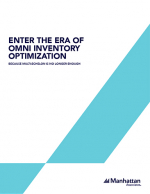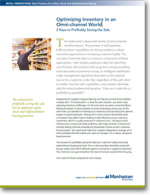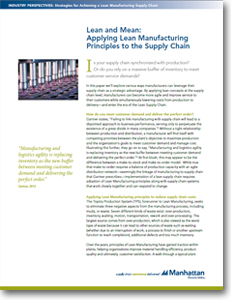Lean and Mean: Applying Lean Manufacturing Principles to the Supply Chain
Is your supply chain synchronized with production? Or do you rely on a massive buffer of inventory to meet customer service demands?
In this paper we’ll explore various ways manufacturers can leverage their supply chain as a strategic advantage. By applying lean concepts at the supply chain level, manufacturers can become more agile and improve service to their customers while simultaneously lowering costs from production to delivery—and enter the era of the Lean Supply Chain.
How do you meet customer demand and deliver the perfect order?
Gartner states, “Failing to link manufacturing with supply chain will lead to a disjointed approach to business performance, serving only to perpetuate the existence of a great divide in many companies.”1 Without a tight relationship between production and distribution, a manufacturer will find itself with competing priorities between the plant’s objective to maximize production and the organization’s goals to meet customer demand and manage cost.
Illustrating this further, they go on to say, “Manufacturing and logistics agility is replacing inventory as the new buffer between meeting customer demand and delivering the perfect order.”2 At first blush, this may appear to be the difference between a make-to-stock and make-to-order model. While true that make-to-order requires a balance of production capacity with an agile distribution network—seemingly the linkage of manufacturing to supply chain that Gartner prescribes—implementation of a lean supply chain requires adoption of Lean Manufacturing principles along with supply chain systems that work closely together and can respond to change.
Applying Lean Manufacturing principles to reduce supply chain costs
The Toyota Production System (TPS), forerunner to Lean Manufacturing, seeks to eliminate three negative aspects from the manufacturing process, including muda, or waste. Seven different kinds of waste exist: over-production, inventory, waiting, motion, transportation, rework and over-processing.
The largest source comes from over-production, which is also viewed as the worst type of waste because it can lead to other sources of waste such as waiting (whether due to an interruption of work, a process to finish or another upstream function to reach completion), additional defects and too much inventory.
1 Simon F. Jacobson and Debra Hofman, “Aligning Manufacturing and Supply Chain Performance, Part 1: Crossing the Divide,” Gartner Inc., September 20, 2010, p. 1
2 Ibid., p. 2
What’s Related




Favorites





